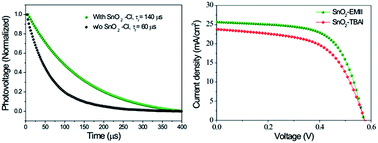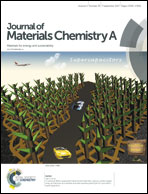Low-temperature-processed SnO2–Cl for efficient PbS quantum-dot solar cells via defect passivation†
Abstract
Colloidal quantum dots (CQDs) exhibit extraordinary features due to their bandgap tunability and solution processing. Instead of the ZnO layer usually used as the electron transport layer (ETL) in CQD heterojunction devices, we developed, for the first time, tin dioxide (SnO2) as the ETL in colloidal quantum dot solar cells (QDSCs). Its wider bandgap and higher electron mobility, as well as appropriate band alignment with PbS QDs, could favor light absorption and photocarrier extraction. Our low-temperature processed SnO2 film could retain chlorine atoms (SnO2–Cl) to achieve interface passivation in QDSCs. Utilizing 1-ethyl-3-methylimidazolium iodide (EMII) as the absorber ligand, our superior device obtained a power conversion efficiency of 9.37%, which was 44% higher than that of a control device. Physical characterizations revealed that this remarkable improvement could be ascribed to the chlorine passivation of the SnO2/QD interface contact and to the EMII ligand passivation effect on the QD surface. Our newly developed ETL, along with an efficient interface passivation technique, is expected to enhance the performance of full solution-processed colloidal QDSCs.



 Please wait while we load your content...
Please wait while we load your content...